#international collectors library
Photo
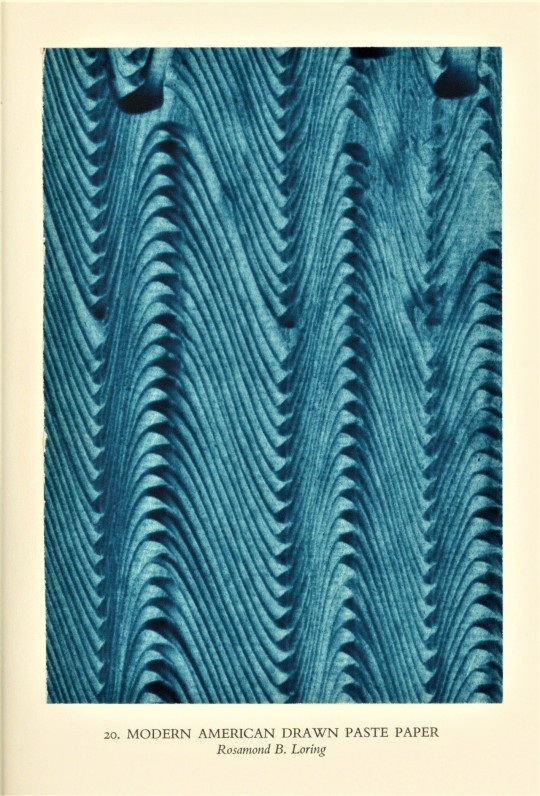
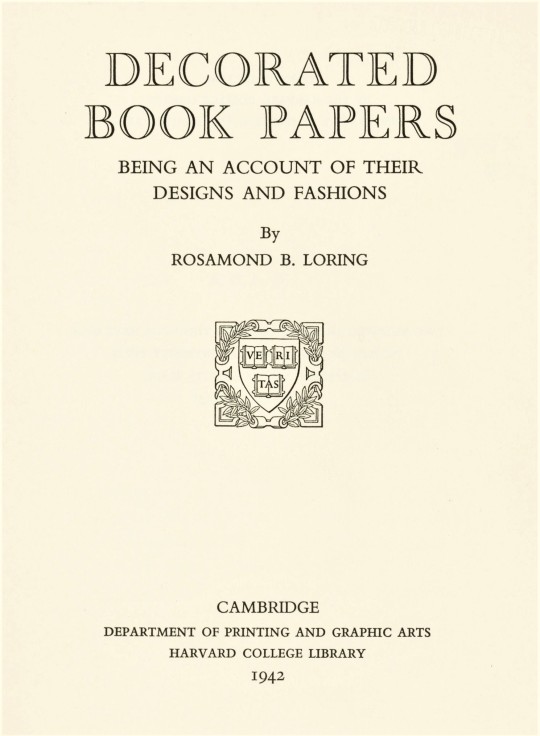




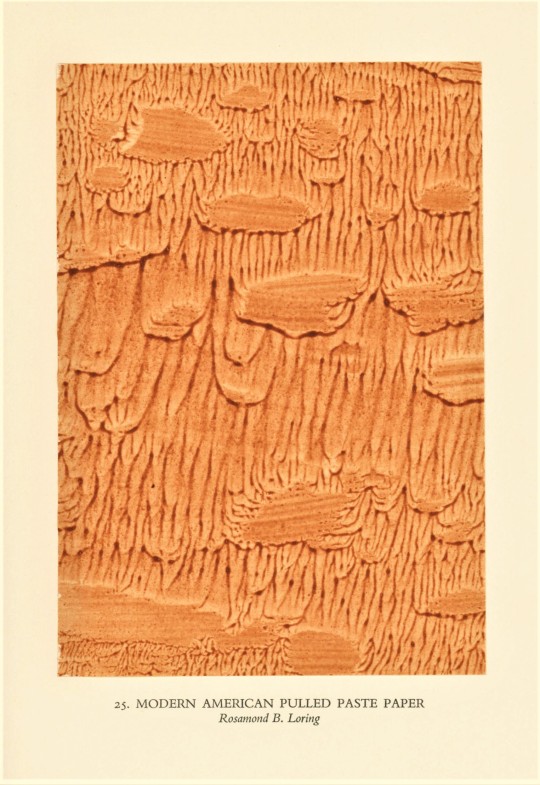

Decorative Sunday: Paste Paper Edition
In 1942, Harvard University Press printed 250 copies of Decorated Book Papers: Being an Account of the Designs and Fashions by the bookbinder, author, and creator and collector of decorative papers, Rosamond Bowditch Loring. Published by the Harvard College Library Department of Printing and Graphic Arts in Cambridge, Massachusetts, the 234 sale copies of the first edition sold out within months, despite the “then considerable price of ten dollars” and the economic stressors of the war. In addition to eight plates reproducing examples of 18th century decorative papers, the first edition includes twenty-five samples tipped in, many of which are from the author’s own extensive collection.
While Loring collected a variety of a decorative papers, the examples shown here are from the chapter on paste papers, Loring’s area of creative specialization. The sample papers included in this chapter are all Loring’s own work, or that of her student, Veronica Ruzicka, who bound the first edition (it is worthy to note that Ruzicka is the daughter of illustrator, wood engraver, and type designer Rudolph Ruzicka, whose work we have highlighted several times). Ruzicka also contributed an essay when a second edition of the book was finally published by Harvard University Press in 1952, along with Dard Hunter and Walter Muir Whitehall.
Rosamond Loring (May 2, 1889 – September 17, 1950) studied book binding under Mary Crease Sears at the Sears School of Bookbinding in Boston. Sears, about a decade older than Loring, had had to battle to learn the trade; women were barred from the Bookbinders Union but most commercial binderies were happy to hire women for particular tasks, such as sewing sheets, but maintained a strict separation of roles, preventing employees from learning the whole binding process from start to finish. Eventually, Ms. Sears secured an apprenticeship in France to complete her studies and opened her binding school in Boston shortly after, training several generations of women binders. While studying under Sears, Loring became frustrated with the lack of options for quality endpapers and became determined to make her own, which she sold to other binders at Ms. Sears’s studio. Her first major commercial commission was for the Houghton Mifflin publication of The Antigone of Sophocles, translated by John J. Chapman (Boston, 1930).
Our copy of Decorated Book Papers is a gift of Dick Schoen.
-Olivia Hickner, Special Collections Graduate Intern
#Decorative Sunday#Decorated Book Papers#Rosamund Bowditch Loring#Rosamund Loring#Rose Loring#Paste Paper#Paste Papers#Decorative Paper#End-Paper#Decorative Plates#Decorative Art#Decorative Arts#Veronica Ruzicka#Dard Hunter#Walter Muir Whitehill#John J. Chapman#Harvard University Press#Harvard College Library#Harvard College Library Department of Printing and Graphic Arts#olivia
162 notes
·
View notes
Text
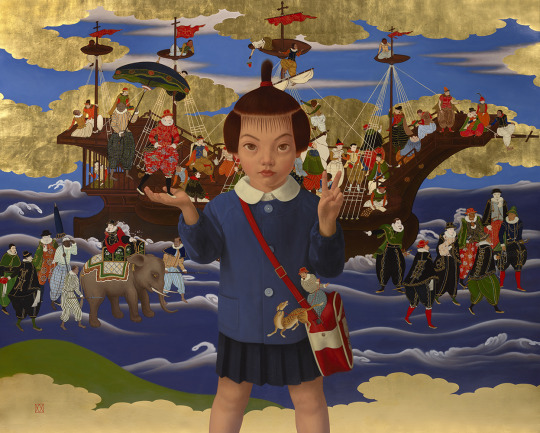


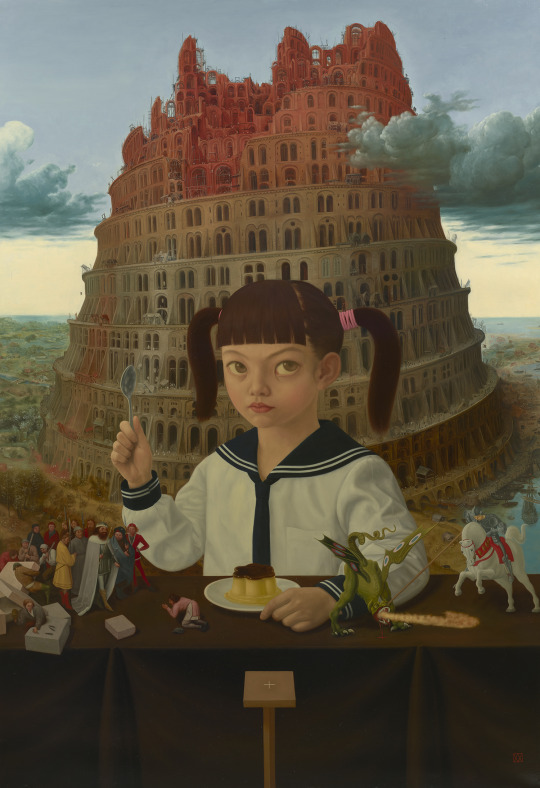
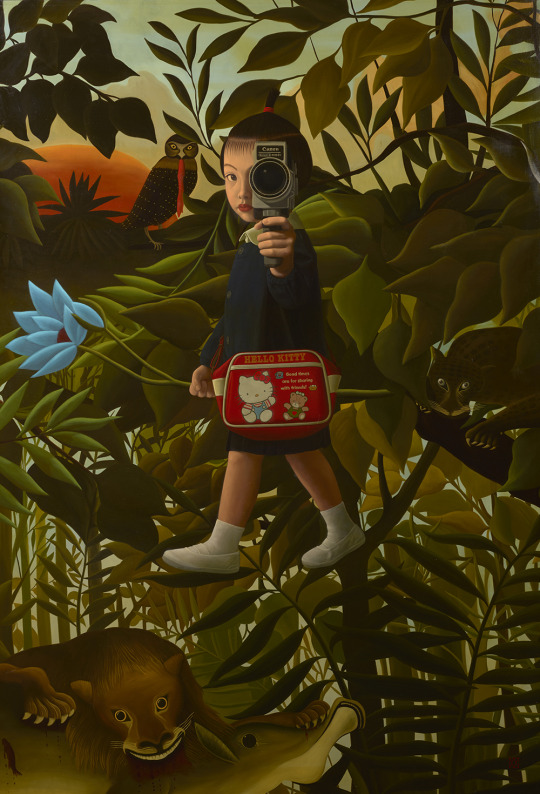
Mitsuru Watanabe, Japanese, b. 1953
Mitsuru Watanabe was born in 1953 in the Aomori Prefecture in Japan, the youngest of four siblings. His mother was an amateur painter who set an example for her children, not only with her own work, but also with an extensive library of art books in the family home. The young Mitsuru gradually began to browse through the books, thus introducing himself to a wide variety of styles, aesthetics and historical images. In addition, he poured over books on drawing and painting techniques, establishing a foundation for his future work as a professional artist.
His junior high school did offer an art class, but it was not particularly inspiring, and in high school, there was no art education offered. That left Mitsuru to study on his own, and after graduation in 1972, he again consulted art books about painting techniques, which provided some basic guidance. His introduction to professional training came as a result of an advertisement that he placed in an art magazine in the hope of attracting some clients for his painting. Instead one of his paintings was purchased by a collector on behalf of the painter Seiichiro Ban (b. 1950), who was impressed with the younger artist’s work. He invited Mitsuru to Kyoto, eventually teaching him “everything about painting techniques”, including the use of oils, brushwork and color adjustment. In the process, the two men became good friends.
Meanwhile, Mitsuru worked for a printing company for a few years. Eventually, he gave it up in order to paint, and for several years, he paid the bills by gambling at mahjong and pachinko (Japanese pinball). In spite of the hardships of such an uncertain mode of living, he looks back fondly on this period.
By 1975, he met and married his wife, and moved to Hachinohe City. The family soon grew to include a son and two daughters. Looking back on those early days, Mitsuru recalls spending many days reading in a library while taking care of his son. He requested books on philosophy, religious studies, cultural anthropology, psychoanalysis and contemporary criticism, all of which the library provided. A few years later, when his paintings were selling well, a librarian mentioned to him that they had spent over 200,000 yen per year on his requests; and that his absence from the library meant that they no longer had such a generous budget allotment.
With a growing family, Mitsuru realized that he would need to increase his income. He had become friends with a local theatrical troupe, even writing a play for the group at one point, and thought that they might be interested in purchasing some of his paintings. With these funds, he was able to organize a successful solo exhibition in Hachinohe. Ultimately, he was able to raise enough money to advertise his work in an art magazine and stage an exhibition in Ginza. Most of the paintings sold and Mitsuru’s career was launched.
In the 1980s, Japan was enjoying an economic boom, including the market for contemporary art. Although progress was slow initially, Mitsuru’s work began to attract attention in Tokyo. When he won the 10 million yen prize in the Second Ryohei Koiso Grand Prize Exhibition in 1994, the gallery world took notice. Soon he was working with a gallery in Ginza, which in turn led to Mitsuru’s art being noticed by a Hong Kong gallery; this broadened the international market for his art.
In 1990, Mitsuru met and befriended Hiroshi Furuyoshi after seeing an exhibition of his work. Hiroshi’s collection of international art books provided inspiration, and, as Mitsuru notes, Hiroshi “generously taught me about [western] painting techniques.”
His work offers a compelling mix of Japanese and Western traditions. He borrows imagery freely from a number of western artists, ranging from Pieter Brueghel and Hieronymus Bosch to Henri Rousseau. These “borrowed images” are grounded in the Japanese tradition of shyakkei (borrowed landscape) which utilizes nearby natural landmarks as the backdrop to the design of a garden. Likewise, Mitsuru incorporates traditional western images both as the stage for his work and occasionally as commentary in the form of small visual quotations from old master paintings by Peter Paul Rubens, Raphael, Michelangelo, and Erie Loran, as well as the Japanese contemporary artist Hayami Gyosyu.
Almost all of Mitsuru’s paintings feature his children as his models. In the 2018 painting, In the Forest-with Deposition of Christ, one of his daughters is shown strumming a guitar while comfortably seated in one of Henri Rousseau’s forests. The lion from Rousseau’s painting of The Sleeping Gypsy (1897) grazes casually nearby at a much smaller scale. And on the other side of the canvas, Peter Paul Rubens’ The Descent from the Cross (1612-14) is inserted into the forest landscape as if it were a staged tableau. In the 2019 painting, Naoko Walking in Rousseau’s Forest, the artist’s daughter again appears, this time walking on air with her “Hello Kitty” purse slung over her shoulder and a Canon camera pointed straight at the viewer as if it were a gun.
The combination of humor and serious cultural commentary is characteristic of Mitsuru’s painting. He notes that this too is based on an older Japanese trope, Honka-dori, in which new tanka poetry is created by quoting from famous older tanka poems. Mitsuru has used iconic western paintings coupled with very contemporary Japanese images to initiate a discussion about the cross-cultural influences of each tradition. And his children have become the ambassadors of that conversation. As Mitsuru comments “As long as I live, they will go around the world of painting as a child, like Peter Pan.”
Janet Whitmore, Ph.D.
https://rehs.com/Mitsuru_Watanabe_Naoko_Playing_in_Boschs...
15 notes
·
View notes
Text
My beautiful and/or antique books collection ♥️
American literature

British
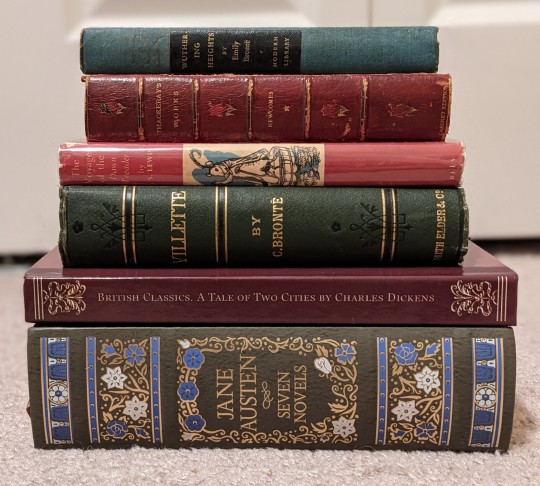
Russian

Heritage Club + Limited Edition Club
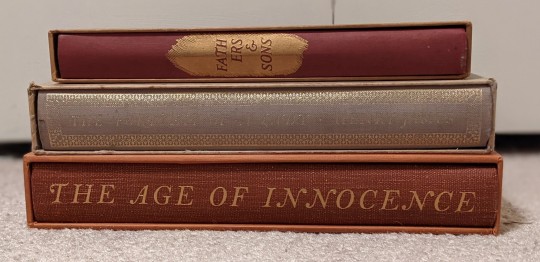
Gone with the Wind
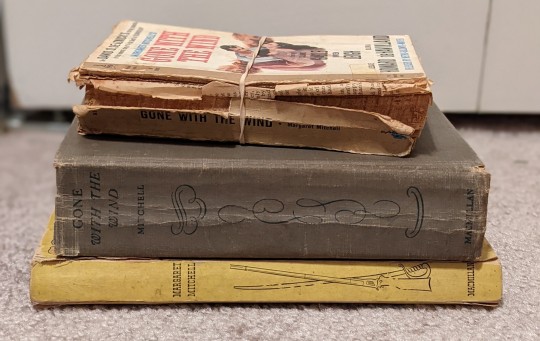
(I've already shared my Narnia and Tolkien books, so I won't repeat those here )
Details on the specific books:
American lit, top to bottom of the stack
Ethan Frome by Edith Wharton, published in 1911. My copy is from 1939 and I got it for 50 cents at a used book sale.
Laments for the Living by Dorothy Parker, published 1930. The latest addition to my collection, purchased yesterday from a used bookstore on a visit to my sister! My copy is a tenth printing from September 1936.
A Library of America anthology of Willa Cather's early novels (1905-1922) that I got for Christmas one year.
The Collected Works of F. Scott Fitzgerald (1920-1940) from the Wordsworth Library Collection. I picked this up at Costco, if you can believe it. Just a basic anthology, but very pretty.
Heritage Club copy of The Portrait of a Lady by Henry James (1881) that I picked up at a used bookstore.
Limited Edition Club copy of The Age of Innocence by Edith Wharton (1920) that my mom bought me for my birthday after someone never returned my original copy. One of the best gifts I've ever received.
British lit
Wuthering Heights by Emily Brontë, originally published in 1847. My copy is the Modern Library edition from 1939. I inherited it from my mom :)
The Newcomes by William Makepeace Thackeray, originally published in 1855. My copy is part of a 26 volume set of Thackeray's works from 1901. I found it for five dollars at an antique store.
The Voyage of the Dawn Treader by C.S. Lewis first edition, second printing. Arguably the jewel of my collection. It's a former library book and I bought it for myself as a reward for surviving the Covid lockdowns lol. In my defense, I'd had my eye on it for a while.
Villette by Charlotte Brontë, originally published in 1853. My copy is from 1887 (!) The other best Christmas gift I've ever received.
A Tale of Two Cities by Charles Dickens (1859). My copy is a British classics edition from an indie publisher where the whole thing is arranged like a newspaper. It's super cool.
Barnes and Noble edition anthology of Jane Austen's works
Russian
And Quiet Flows the Don by Mikhail Sholokhov (1940). My copy is from 1960. Not that antique, but I love it all the same. Another used bookstore find!
International Collectors Library edition of Nicholas and Alexandra by Robert K Massie (1967). They did a really beautiful series of "The World's Greatest Biographies." Yet another used bookstore find (I may spend too much time in used bookstores 😂)
International Collectors Library copy of Doctor Zhivago by Boris Pasternak (1957). Library book sale, I think.
Barnes and Noble edition of Anna Karenina by Leo Tolstoy (1878).
Heritage Club copy of Fathers and Sons by Ivan Turgenev (WITH its Sandglass paper!!). I got it for eight dollars (!) at an antique store.
Gone with the Wind (Margaret Mitchell, 1936)
My mom's copy, dated 1961. It's paperbound and falling apart, but it's one of the most precious objects I own. Probably the #3 object from my house that I would save in a fire.
A copy from 1937. It's an eighteenth printing and not especially valuable, but I think it's super cool that my copy was printed only a year after publication. Definitely the copy that I read/handle most often. From a used bookstore I think?? Genuinely not sure.
The Motion Picture Edition! That's right, I have the edition that got released with the movie in 1939. It's hilarious how similar and yet different it is from modern books like this. Glossy cover with pictures from the movie on the front and back, movie stills interspersed throughout, yet it's 8x10 and the text is set two columns to a page. This came from an antique store and I laugh to myself every time I look at it.
#my pride and joy#hope this post is enjoyable for others and not widely self indulgent lol#pontifications and creations#literature makes us more human
25 notes
·
View notes
Text
my old/beautiful book collection
the pretty books shelves

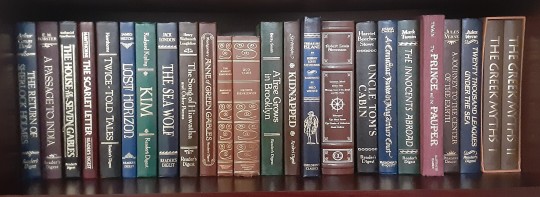
my Tolkien collection

vintage fiction

antique and vintage Bible study books

I have very few truly old books, but more than I remembered are from the early 20th century. List of titles and more details under the cut
pretty books shelves
Reader’s Digest editions: Little Women (Alcott), Tales from the Arabian Nights, Emma & Pride and Prejudice (Austen), Jane Eyre (Brontë), The Last of the Mohicans (Cooper), The Adventures of Robin Hood (Creswick), Two Years Before the Mast (Dana), David Copperfield, Oliver Twist & A Tale of Two Cities (Dickens), The Robe (Douglas), The Adventures, The Further Adventures, The Memoirs, & The Return of Sherlock Holmes (Doyle), A Passage to India (Forster), The House of the Seven Gables, The Scarlet Letter & Twice-Told Tales (Hawthorne), Kim (Kipling), The Sea Wolf (London), The Song of Hiawatha and other poems (Longfellow), Anne of Green Gables (Montgomery), A Tree Grows in Brooklyn (Smith), Kidnapped (Stevenson), Uncle Tom’s Cabin (Stowe), A Connecticut Yankee in King Arthur’s Court & Innocents Abroad (Twain), A Journey to the Centre of the Earth & Twenty Thousand Leagues Under the Sea (Verne)
The Confessions of Saint Augustine—E. B. Pusey translation, Franklin Library edition. This was a Christmas gift from my parents and @bluesidedown has the same one
The Pilgrim’s Progress (Bunyan)—CBN University Press Christian Classics. I don’t actually remember where I got this one but most likely from my dad.
Through the Looking Glass (Carroll)—Heritage Press edition with slipcover and illustrations by John Tenniel. Again, probably from my dad but not 100% sure (he gives me a LOT of books).
The Complete Canterbury Tales (Chaucer)—F. H. Hill translation, Arcturus books with slipcover and illustrations by Edward Burne-Jones and William Morris. Another Christmas gift where Blue and I got matching copies from our parents.
Heretics & Orthodoxy (Chesterton)—Hendrickson Christian Classics. Again, a Christmas gift from my parents.
Nemesis & The Mirror Crack’d From Side to Side (Christie)—Heron Books. Another one I can’t remember the origin of.
The Prairie (Cooper)—Easton Press collector’s edition. From my parents, Christmas this year. This is pretty much the handsomest book I own.
Great Expectations (Dickens)—Chatham River Press. Based on the inscription on the flyleaf this belonged to my dad first. Probably I got it as a gift or in his thinning of his collection.
The Scarlet Pimpernel (Orczy)—International Collector’s Library. Another of unknown origin.
Quo Vadis (Sienkiewicz)—International Collector’s Library. It amuses me that in organizing these books alphabetical by author’s last name, these two matching editions still ended up side by side.
Treasure Island (Stevenson)—Children’s Classics, illustrated by Milo Winter.
Treasure Island–Prince Otto–Strange Case of Dr. Jekyl and Mr. Hyde–Kidnapped–The Black Arrow–The Master of Ballantrae–David Balfour (Stevenson)—Canterbury Classics omnibus. I actually have most of these in other editions, but I keep this for the ones I don’t have elsewhere.....and keep the other editions too because I am a book-dragon.
The Prince and the Pauper (Twain)—Portland House Illustrated Classics, illustrated by Franklin Booth. Not sure where I got this one.
The Greek Myths (Graves)—Folio Society, two volumes in slipcover. These were a Christmas gift from my parents a couple years ago, because I collect fairy tales and folk tales and suchlike.
Tolkien
These are mostly newer Houghton Mifflin or HarperCollins editions. The Silmarillion has Ted Naismith illustrations; Children of Húrin has Alan Lee illustrations, as do the covers of LotR; The Hobbit and LotR have Tolkien’s original illustrations and maps, and Roverandom has cover art by him as well; and Bilbo’s Last Song, Farmer Giles of Ham, The Adventures of Tom Bombadill, and Smith of Wooton Major are all illustrated by Pauline Baynes.
vintage fiction (top down, left column first)
Malory’s Le Morte d’Arthur—Norwood Press, 1911
Stalky & Co. (Kipling)—Macmillan and Co, 1927. Completely leatherbound with gilt spine and seal on the front cover
The Master of Ballantrae & The Black Arrow (Stevenson)—Everyman’s Library, 1938
Popular Fairy Tales (Andersen)—Blackie and Son. No date, but google tells me it’s from sometime in the 30s/40s/50s based on the binding style
Jo’s Boys (Alcott)—The Children’s Press, 1965
Around the World in Eighty Days (Verne)—Dean and Son. No date, but I’m guessing mid-twentieth century
Three Cheers Secret Seven (Blyton)—Brockhampton Press, 1960
The Burgess Animal Book for Children—Little, Brown, and Company. Copyright 1948, though likely printed later
At the Back of the North Wind (MacDonald), The Little Lame Prince (Mulock), King Arthur and his Knights (Frith), All the Mowgli Stories (Kipling)—Junior Deluxe Edtions. Illustrations are copyright 1956, no print dates
The Door in the Wall (de Angeli)—Doubleday. Copyright 1949, no print date
Freckles (Porter)—Grosset & Dunlap, 1916. Very beat up and mostly held together by packing tape on the spine
The Call of the Wild (London)—Grosset & Dunlap, 1910. It has a very faded picture glued to the front cover as part of the original binding, as well as illustrations throughout. Quite worn, with many pages about to or falling out
Kilmeny of the Orchard (Montgomery)—Ryerson, 1947. This was actually printed before the Anne series was entirely published, as the list of Montgomery’s works in the front only includes the first three books in the series
Captains Courageous (Kipling)—Thrushwood Books. Date uncertain, but google tells me probably 1950s
Heidi (Spyri)—Collins, 1958. While this did originally belong to my dad, it’s the copy I read as a kid and has been on my shelf for a long time
The Mark of the Horse Lord (Sutcliff)—Oxford University Press, 1965. I learned in making this list that my copy is probably a first edition, albeit rather beat up from being a school library copy.
Warrior Scarlet (Sutcliff)—Oxford University Press, 1966. I also have a 1973 copy that still has its dust jacket.
Robinson Crusoe (Defoe)—Dent/Dutton, 1966. A beloved favourite copy that I read many times
Twenty Thousand Leagues Under the Sea (Verne)—Charles Scribner’s Sons, 1953. Another beloved copy that I read many times, I flatly refuse to part with this one despite having a less faded and beat-up edition because 1) I am dreadfully sentimental and 2) the illustrations in this edition are much better than in the RD edition.
King Arthur and His Knights of the Round Table (Lanier)—Illustrated Junior LIbrary. Illustrations copyright 1950, no print date
antique and vintage Bible study books
Young’s Analytical Concordance—per a pencil note on the title page this was published circa. 1937, and it definitely looks the part
The Bible as History in Pictures (Keller)—Published in 1964, this is definitely outdated in terms of archaeological evidence of Bible events but it still fascinates me to see
The New English Bible: New Testament—as a Library Edition, I don’t think this strictly counts as a first edition, but it is definitely an early edition as it was printed in 1961 when the NT translation was completed (OT translation of this version wasn’t completed until 1970)
Exposition of Genesis (Leupold)—Wartburg Press, 1942
The Epistle to the Hebrews (Brown)—Banner of Truth, 1961
Luke the Physician (Ramsay)—Baker Book House, 1956
The Gospel in Ezekiel (Guthrie)—Adam and Charles Black, 1857 (or MDCCCLVII if you prefer). This is the oldest book I own, and while is is now quite beat up - the spine is 80% tape and the front cover has come off completely and been replaced with cardboard - I can tell it was a very handsome book when it was new. The spine is bound in dark blue and brown leather, with gilt lettering and decoration, and the edges of the pages have beautiful multicolour marbling on them.
#ooops this is veeeery long#in my defence i have rather a lot of books#so even the fraction that are old/beautiful is quite a few#to quote leah: hope this is enjoyable to others and not just wildly self-indulgent#i had fun and learned a few things about the books i own#and remembered a few i had forgotten i have#about
11 notes
·
View notes
Text
Events 2.13 (after 1940)
1945 – World War II: The siege of Budapest concludes with the unconditional surrender of German and Hungarian forces to the Red Army.
1945 – World War II: Royal Air Force bombers are dispatched to Dresden, Germany to attack the city with a massive aerial bombardment.
1951 – Korean War: Battle of Chipyong-ni, which represented the "high-water mark" of the Chinese incursion into South Korea, commences.
1954 – Frank Selvy becomes the only NCAA Division I basketball player ever to score 100 points in a single game.
1955 – Israel obtains four of the seven Dead Sea Scrolls.
1955 – Twenty-nine people are killed when Sabena Flight 503 crashes into Monte Terminillo near Rieti, Italy.
1960 – With the success of a nuclear test codenamed "Gerboise Bleue", France becomes the fourth country to possess nuclear weapons.
1960 – Black college students stage the first of the Nashville sit-ins at three lunch counters in Nashville, Tennessee.
1961 – An allegedly 500,000-year-old rock is discovered near Olancha, California, US, that appears to anachronistically encase a spark plug.
1967 – American researchers discover the Madrid Codices by Leonardo da Vinci in the National Library of Spain.
1975 – Fire at One World Trade Center (North Tower) of the World Trade Center in New York.
1978 – Hilton bombing: A bomb explodes in a refuse truck outside the Hilton Hotel in Sydney, Australia, killing two refuse collectors and a policeman.
1979 – An intense windstorm strikes western Washington and sinks a 0.5-mile (0.80 km) long section of the Hood Canal Bridge.
1981 – A series of sewer explosions destroys more than two miles of streets in Louisville, Kentucky.
1983 – A cinema fire in Turin, Italy, kills 64 people.
1984 – Konstantin Chernenko succeeds the late Yuri Andropov as general secretary of the Communist Party of the Soviet Union.
1990 – German reunification: An agreement is reached on a two-stage plan to reunite Germany.
1991 – Gulf War: Two laser-guided "smart bombs" destroy the Amiriyah shelter in Baghdad. Allied forces said the bunker was being used as a military communications outpost, but over 400 Iraqi civilians inside were killed.
1996 – The Nepalese Civil War is initiated in the Kingdom of Nepal by the Communist Party of Nepal (Maoist-Centre).
2001 – An earthquake measuring 7.6 on the Richter magnitude scale hits El Salvador, killing at least 944.
2004 – The Harvard–Smithsonian Center for Astrophysics announces the discovery of the universe's largest known diamond, white dwarf star BPM 37093. Astronomers named this star "Lucy" after The Beatles' song "Lucy in the Sky with Diamonds".
2007 – Taiwan opposition leader Ma Ying-jeou resigns as the chairman of the Kuomintang party after being indicted on charges of embezzlement during his tenure as the mayor of Taipei; Ma also announces his candidacy for the 2008 presidential election.
2008 – Australian Prime Minister Kevin Rudd makes a historic apology to the Indigenous Australians and the Stolen Generations.
2010 – A bomb explodes in the city of Pune, Maharashtra, India, killing 17 and injuring 60 more.
2011 – For the first time in more than 100 years the Umatilla, an American Indian tribe, are able to hunt and harvest a bison just outside Yellowstone National Park, restoring a centuries-old tradition guaranteed by a treaty signed in 1855.
2012 – The European Space Agency (ESA) conducted the first launch of the European Vega rocket from Europe's spaceport in Kourou, French Guiana.
2017 – Kim Jong-nam, brother of North Korean dictator Kim Jong-un, is assassinated at Kuala Lumpur International Airport.
2021 – Former U.S. President Donald Trump is acquitted in his second impeachment trial.
2021 – A major winter storm causes blackouts and kills at least 82 people in Texas and northern Mexico.
1 note
·
View note
Text

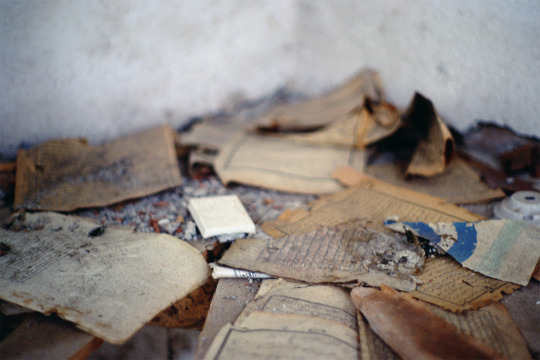
Middle East Medievalists (MEM,) an association of scholars promoting the study of medieval Middle East awarded its Lifetime Achievement Award to our former colleague, András Riedlmayer for his service as librarian and archivist at Harvard and his work cataloging crimes against cultural heritage in the Balkans, including testifying in international war crimes tribunals against Slobodan Milošević. We are so proud of András!
For those of you who are not familiar with András lifework on documenting crimes against cultural heritage in the Balkans, you can listen to the interview on Ottoman History Podcast. https://www.ottomanhistorypodcast.com/2017/03/balkan-waqf.html
The destruction of Ottoman-era waqf institutions and other cultural heritage in the Balkans during the wars of the 1990s was extensive, from masjids and tekkes to bridges and libraries. A bibliographer at Harvard's Fine Arts Library, András Riedlmayer, traveled throughout the region to document this destruction during and after the wars. In this podcast, Riedlmayer describes his work on waqf institutions in the Balkans and his testimonies about the destruction of culture for international war tribunals over the last two decades. We discuss the fate of antiquities during wars and the ethical implications for historians, collectors and museums. (From Ottoman History Podcast: Documenting the Destruction of Balkan Waqf Institutions, Episode 305)
Image 1: András testifying at the International Court of Justice in March, 2006 (Photo courtesy of András Riedlmayer)
Image 2: Carralevë, Kosovo. Inside the burned-out village mosque, October 1999. Torn and desecrated pages from Qur’ans and religious books in the aftermath of the Kosovo war. (Photo courtesy of András Riedlmayer)
#AndrásRiedlmayer#MiddleEastMedievalists#documentingculturalheritage#librarian#lifetimeachievement#ourcolleague#HarvardFineArtsLibrary#Fineartslibrary#Harvard#HarvardLibrary#harvardfineartslibrary#fineartslibrary#harvard#harvard library#harvardfineartslib#harvardlibrary
9 notes
·
View notes
Text
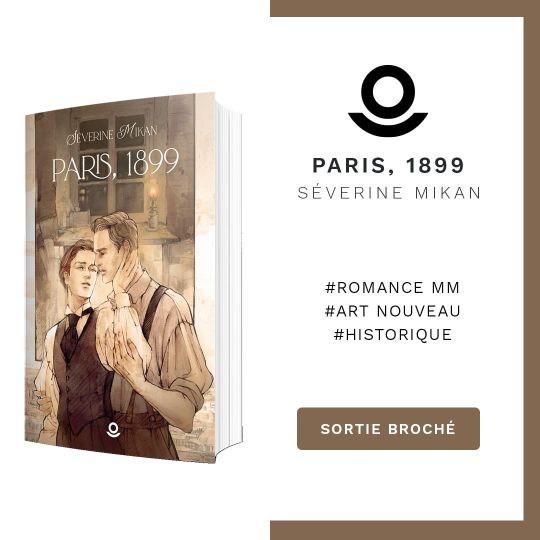

My best-selling novel "Paris,1899" has a new collector release this month !!! With art nouveau'style illustrations and a new cover, and it's so greaaaaaat (ok, I'm a little bit over the top with this).
It's in French. If you're looking for an international shipping go there : Library on line.
6 notes
·
View notes
Text
My Cousin Rachel by Daphne Du Maurier
published on: 1951
edition: International Collector's Library

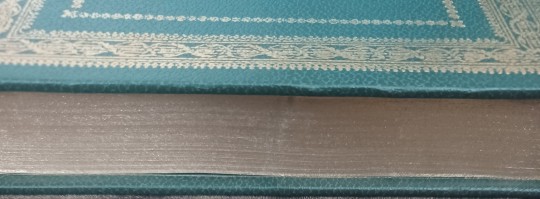
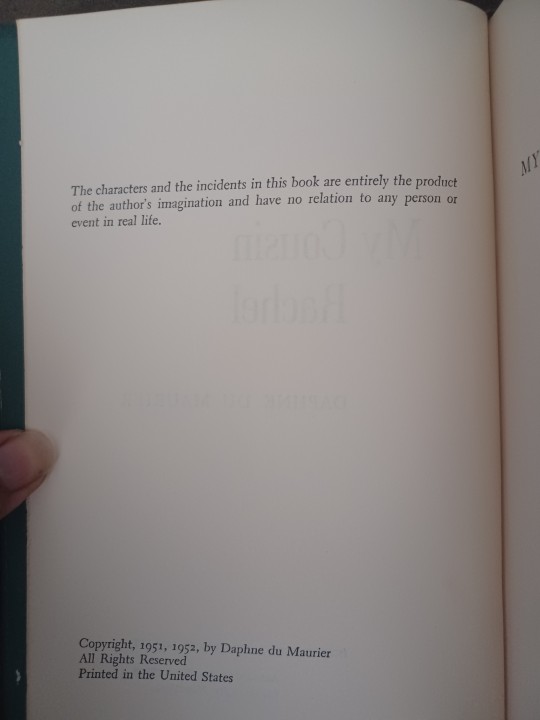


I've been waiting to reread this baddy almost a decade! 🥺 the latest addition to my bookshelf & TBR pile
2 notes
·
View notes
Video
youtube
Through Reading, Dongguan Builds Bridges Connecting the World
Global Relay of 23 Cities Celebrates, "Fragrance of Books Dongguan · World Walk and Read+" Public Reading Festival Unfolds
Dongguan, April 23, 2024 — Today marks the 29th "World Book Day" and coincides with the National Public Library Service Promotion Week. The grand opening of the "Fragrance of Books Dongguan · World Walk and Read+" public reading festival was held at the 423-meter tall Min Ying·Guo Mao Center in Dongguan. This event, jointly hosted by the Municipal Party Committee Propaganda Department, the Municipal Culture, Radio, Film, Tourism and Sports Bureau, the Dongguan "Hundreds, Thousands, Millions Project" Command Office, and the Dongcheng Sub-district Office, simultaneously kicked off over 500 activities related to World Book Day, aiming to create an atmosphere of "universal sharing, full coverage, industry integration, and multi-media broadcasting."

This reading festival, themed "Fragrance of Books Dongguan · World Walk and Read+," uniquely featured the "4·23 City Reading Relay." This innovative "Advocacy + Walk and Read" format issued a heartfelt invitation to read to cities worldwide under the name of Dongguan. Special guests including Dongguan’s overseas Chinese, students studying abroad, employees of Dongguan-based enterprises overseas, and representatives from sister cities and partner cities, collaborated with partners from 23 cities around the globe to engage in synchronized reading activities, pushing the "Fragrance of Books Dongguan" brand onto a broader international stage.
Internationally, friendly cities like Baesa in Spain, Paksé in Laos, and Holon in Israel actively participated. By using reading as a common language, these cities bridged geographical and cultural divides, radiating positive energy through reading. Furthermore, cities such as Tumxuk in Xinjiang and Tongren in Guizhou, which Dongguan supports, also joined, showcasing Dongguan’s open and inclusive city image to the nation and the world.
Several renowned personalities with deep ties to Dongguan also participated in the event. Among them, Lun Zhiqing, a descendant of the famous book collector Lun Ming, issued a reading call from Beijing. Zhao Heng, daughter of the famed translator Yang Yi and contributor to "Easy Read," shared her connection with the bookish charm of Dongguan city. Chen Bei’er, a popular TV host from Hong Kong's TVB, energetically promoted the "Fragrance of Books Dongguan" brand. Chen Jiayi, a young violinist and representative of overseas students who won the 10th China Music Golden Bell Awards, played a beautiful melody on her violin in Austria, echoing the elegant chapter of "Fragrance of Books Dongguan." Other overseas Chinese such as Lee Yuh Ping, founding chairman of the Chinese Librarians Association Asia-Pacific Branch in Singapore, and Zhong Yayi in Fiji, supported and promoted the "Fragrance of Books Dongguan" brand through their actions and words. Employees of Kuaiyi Elevator in Dubai showcased the strength and cultural charm of Dongguan manufacturing through their reading and sharing activities.
Distinguished guests such as Wang Weihua, academician of the Chinese Academy of Sciences and director of the Songshan Lake Materials Lab, and Zhao Gansen, a National May 1st Labor Medalist and well-known professor at South China Normal University's School of Computer Science, among others, cheered on the "World Book Day" event series. The launch ceremony was graced by Wang Yuguang, professor and doctoral supervisor from the Department of Information Management at Peking University, and Liu Zhimeng, a European Academy of Natural Sciences academician and professor at Dongguan University of Technology, who shared their reading insights with attendees, affirming the efforts of Dongguan in recent years in building the "Fragrance of Books Dongguan" brand.
Through such events, Dongguan not only demonstrates its cultural openness and inclusiveness to the world but also communicates the positive message of promoting cultural exchange and knowledge sharing through reading. Dongguan’s efforts and achievements undoubtedly set a new standard for global cultural exchange, showcasing the city’s growing significance on the global cultural map.
0 notes
Text
25/16
16/4/24
Inverted Head Four Annas 1854
( The Curious Case of An Upside Down Postage Stamp )
Inverted Head Four Annas Stamp of Eighteen Fifty Four
Merely showed coming events cast their shadows long before !
Survey Office Calcutta of the Mighty Brit Empire
Lithographed octagonally a Die Printing Entire
The frame was red the head was blue the head of Queen Victoria
Some illiterate native workman goofed up in his euphoria
On Day One of the Operation the red frames were imprinted
And left to dry so that next day the blue head could be printed
October the Thirteenth of Eighteen hundred Fifty Four
Was that first day and all went well on that Oriental shore
October the Fourteenth however proved another matter
Perhaps the first day’s concentration had begun to scatter
At least six sheets with the red frames were turned top down and then
The Monarch’s head in Royal Blue was added by workmen
The head was not inverted, mind, it was in fact the frame
And yet the end result was upside down heads all the same
No offence meant, it was all done quite inadvertently
And proof that it was so is before us historically
For although two million six thousand forty stamps were printed
It was a score of years before someone so squarely squinted
That they could see the mistake and ensure in the reprint
Of Eighteen Ninety One the stamp was right and fresh as mint
EA Smythies has noted that the issue came to light
In London Eighteen Seventy Four’s Philatelic Oversight
LR Hausberg has mentioned it in Nineteen Hundred Seven
Mr Sefi a year after Nineteen Hundred Eleven
Three cut to shape examples are in the Tapling Collection
At the British Library, London, in all their flawed perfection
Including two (positions three and four on the printed sheet )
On cover indicating that detection was complete
The error was created by an incorrect sheet placement
Rather than careless die transfer, that is the final judgement.
In all, now , only twenty-eight examples can be found
That can be certified as genuine, valuable, sound.
Valued today at one million and seventy thousand dollars
These stamps can leave many collectors hot under their collars
A stamp that at the time was not worth more than dime or quarter
Has got back its revenge today in international barter
Imperialism has been made to stand upon its head
And forced to issue repeated apologies instead.
Therefore I say Inverted Head Stamp Eighteen Fifty Four
Merely showed coming events casting their shadows before !
( ASA )
#amitasinfinity
#24GloPoNaPoWriMo
0 notes
Text
Cool Finds
Turkish Garbage Collectors Curate Their Own Library
The sanitation workers have already amassed a collection of more than 6,000 books
Jason Daley
Correspondent
February 23, 2018
...
While Turkey does have its own public library system, run by the Ministry of Culture and Tourism, in 2017 Turkey's Daily Sabah noted that there is currently just one public library for every 70,000 people in Turkey. In sharp contrast, the "Library Map of the World" for 2016 chronicled that there was one public library for every 6,200 people in the European Union.
Agence-France Presse reports that the sanitation worker's collection of books is housed in a former brick factory, whose long corridors proved well-suited for a library. The building itself also serves as a community social hub, and includes a barber shop, a cafeteria, a lounge with chess boards and administrative offices (some of which are furnished with furniture and office equipment that's also been rescued from the trash).
The library's books have been divided into 17 categories, including romance, economics and children’s fiction, and the collection is still growing. Not only do the workers continue to collect books while on their shifts, but by last count they still have 1,500 books that they need to catalogue and shelve. Additionally, people are now sending them books through the mail.
...
0 notes
Photo







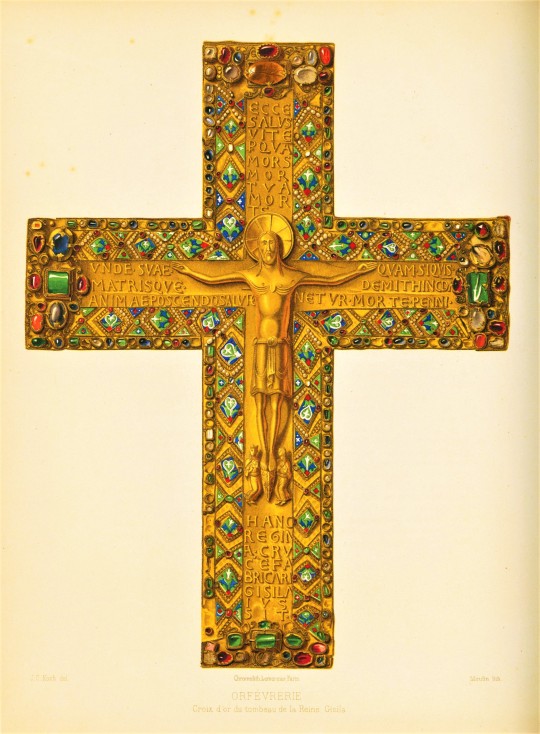

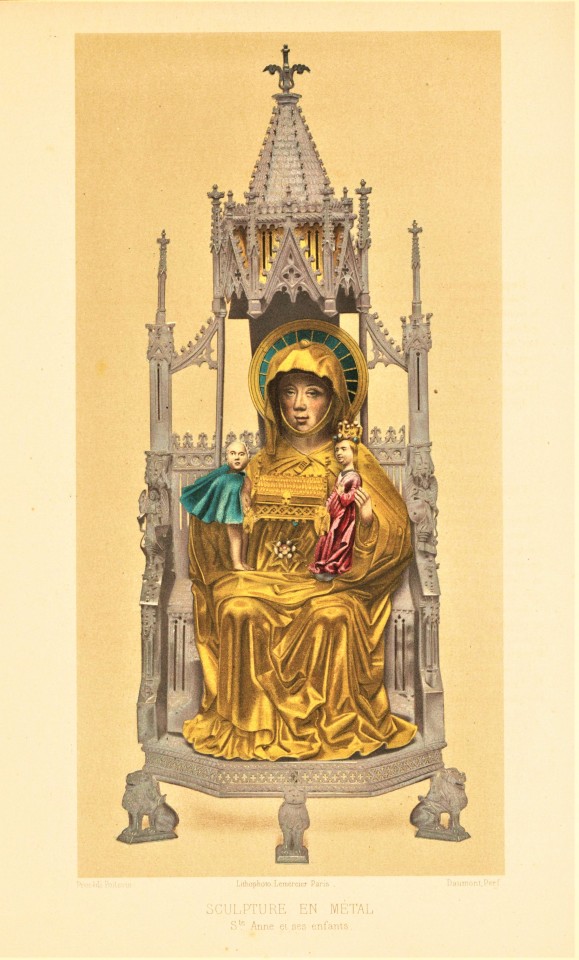
Decorative Sunday
In 1823, an aspring young lawyer named Jules Labarte (1797-1880) married Joséphine Debruge-Duménil*, the only daughter of the wealthy art collector Louis-Fidel Debruge-Duménil (1788-1838). He was enthralled by his father-in-laws collection, one of the first major private collections of Medieval and Renaissance Art in France, and by 1835 he had abandoned the law to dedicate himself to the study of art history. A few years later, Debruge-Duménil passed away unexpectedly, and Labarte was charged with identifying and cataloging his collection of over fifteen thousand artifacts, a task he took on with great meticulousness.
The resulting catalog was published in 1847 by La Librarie Archeonologique de Victor Didron with a 400 page introduction. This well-researched introduction became a highly sought after text, and Didron pressed Labarte for years to produce a second edition. Labarte refused for years, but allowed for a English translation, published in 1855 by J. Murray of London as Handbook of the Arts of the Middle Ages and Renaissance as Applied to the Decoration of Furniture, Arms, Jewels, Etc.
The English edition only increased the appetite for a revised French edition, to which Labarte finally agreed. Between 1864 and 1866, Histoire des arts industriels au Moyen Âge et à l'époque de la Renaissance was published in Paris by A. Morel et Cie. in four volumes, with two additional volumes of plates. Printing was done by Henri Plon, an ancestor of 16th century Danish typographer Jehan Plon. The plates are primarily chromolithographs produced by Lemercier, the largest lithography firm in Paris at the time. Keep your eyes peeled for a follow up post where we will share images from the second album and discuss Rose-Joseph Lemercier (1803-1887).
The above images are all sourced from the first album of plates. Critics praised the book’s illustration for its rich colors and “photo-like accuracy.” You might look at the last image above (of the statue St. Anne and her Children by German artist Hans Greiff) and question that characterization based on the somewhat bizarre faces, but lo and behold, the faces on the actual statue are a bit strange! See for yourself:

Find more posts on publisher August Morel here.
Peruse more Decorative Sunday posts here.
-Olivia, Special Collections Graduate Intern
*Special shout out to Institute National d’Histoire de l’Art (INHA) for providing me with the first name of Labarte’s wife Josephine, who is most commonly (and annoyingly) referred to in the literature as “daughter of Louis-Fidel Debruge-Duménil” or “wife of Labarte.”
#Decorative Sunday#Histoire des Arts Industriel#decorative arts#decorative plates#Jules Labarte#La Librarie Archeonologique de Victor Didron#Histoire des Arts Industriels au Moyen Âge et à l'Époque de la Renaissance#A. Morel et Cie.#A. Morel#Lemercier#chromolithographs#chromolithography#Yay chromoliths!#Louis-Fidel Debruge-Duménil#Joséphine Debruge-Duménil#Handbook of the Arts of the Middle Ages and Renaissance as Applied to the Decoration of Furniture Arms Jewels Etc.#Handbook of the Arts of the Middle Ages and Renaissance#John Murray#J. Murray#Henri Plon#Jehan Plan#olivia
67 notes
·
View notes
Link
0 notes
Text
9/10/23 - W.E.B. DU BOIS
'This empire is a coloured empire.' (Du Bois, 2022, p.255).
REFERENCE
Du Bois, W.E.B. (2022 [1911] ) 'London', in Adi, H. (ed). 'Black voices on Britain'. London: Macmillan Collector's Library, pp.255-7).
*****
SEE ALSO
'Yet London is uneasy. London is sensing the strength and determination in the darker world and is wondering what it all portends in the future.' (Du Bois, 2022, p.256).
LAST WEEK IN THE NEWS
2/10/23
' “Lucius Blake is just one of the hundreds of people of colour who have been lost to British film history,” said Marc David Jacobs, who will be delivering a presentation on the subject at BFI Southbank on Monday in celebration of Black History Month.' (Khomami, 2023).
…
3/10/23
‘ “The wind of change that carried my own parents across the globe in the 20th century was a mere gust compared [with] the hurricane that is coming,”she said. “Because today, the option of moving from a poorer country to a richer one is not just a dream for billions of people. It’s an entirely realistic prospect.” ‘ (Syal, 2023).
…
4/10/23
‘ ... Sunak went into details about his own heritage, telling a story about his grandfather touring parliament, and addressed his background in a way he has rarely done before, saying he was proud to be the UK’s first British-Asian prime minister – but also proud that it wasn’t a big deal.’ (Mason, 2023).
…
5/10/23
‘New legislation to revitalise Peru’s film industry has been proposed after the makers of the British comedy Paddington in Peru chose Colombia as the filming location for the section of the movie in which the bear finally returns to his home country.’ (Collyns, 2023).
…
6/10/23
‘ “I think what adds to her allure is that she’s a Black girl from Streatham who made it big – no famous parents, the only woman of colour in shows and campaigns for decades,” … ‘ (Osman Ahmed in MacDonnell, 2023).
…
7/10/23
‘Samoa were penalised 14 times in their 18-17 defeat, five more than England, and were shown the only yellow card. Coach Seilala Mapusua rejected the idea that his players needed more exposure to Test match referees, and argued that the problem was his players were being treated differently.’ (Bull, 2023).
…
8/10/23
‘A solidarity demonstration will be held in Liverpool by Labour Black Socialists and Momentum’s black caucus calling for the 70-year-old to be welcomed back after a six-month racism row.’ (Helm, 2023).
…
REFERENCES
Bull, A. (2023) ‘Samoa coach accuses referees of “unconscious bias” against tier two sides’, Guardian 7 October [Online]. Available at: https://www.theguardian.com/sport/2023/oct/07/samoa-coach-accuses-referees-of-unconscious-bias-against-tier-two-sides (Accessed 8 October 2023).
Collyns, D. (2023) ‘Paddington in Peru films in Colombia – sparking row over legislation in Peru’’, Guardian 5 October [Online]. Available at: https://www.theguardian.com/world/2023/oct/05/paddington-in-peru-legislation-film-industry(Accessed 8 October 2023).
Helm, T. (2023) ‘Protest increases pressure on Starmer to restore Labour whip to Diane Abbott’, Guardian 8 October [Online]. Available at: https://www.theguardian.com/politics/2023/oct/08/protest-increases-pressure-on-starmer-to-restore-labour-whip-to-diane-abbott (Accessed 8 October 2023)
Khomami, N. (2023) ‘Overlooked black actor may have been most prolific in early British cinema’, Guardian 2 October [Online]. Available at: https://www.theguardian.com/world/2023/oct/02/overlooked-black-actor-may-have-been-most-prolific-in-early-british-cinema (Accessed 8 October 2023).
MacDonnell, C. (2023) ‘It’s a Naomissance: how Naomi Campbell has transcended fashion’, Guardian 6 October [Online]. Available at: https://www.theguardian.com/fashion/2023/oct/06/how-naomi-campbell-transcends-fashion-model-profile-v-and-a (Accessed 8 October 2023).
Mason, R. (2023) ‘Tories hoping “more Rishi” is the answer to flagging poll ratings’, Guardian 4 October [Online]. Available at: https://www.theguardian.com/politics/2023/oct/04/tories-hoping-more-rishi-is-the-answer-to-flagging-poll-ratings (Accessed 8 October 2023).
Syal, R. (2023) ‘Suella Braverman claims “hurricane” of mass migration coming to UK’, Guardian 3 October [Online]. Available at: https://www.theguardian.com/politics/2023/oct/03/suella-braverman-claims-hurricane-of-mass-migration-coming-to-uk (Accessed 8 October 2023).
*****
BLACK/BAME/GLOBAL MAJORITY HISTORY MONTH 2023
*****
GLOBAL MAJORITY HISTORY MONTH
*****
QUOTE OF THE WEEK 2011 - 2023

…
12 EPIC YEARS
FROM THE ARCHIVE

…
23/4/18
*****
0 notes
Text
So I wrote this think last night and I'm not sure why, but I did. It was improvised/stream of consciousness, so the vibes definitely change like halfway through oops.
Here lies my heart
Between two lungs, spine behind and bone before
She beats like a drum, or ticks like a clock, or what have you. At least that’s what the rule book says
But mine doesn’t.
Still she stands. Blood pours through her like sands through an hourglass.
Rivers run within me, cold and sometimes clear, but more often than not the muck at the bottom has been stirred by someone’s hand brushing the surface or a foot stuck deep within and she runs brown and cloudy.
Sometimes I see within me a tall cage of black metal with a little door to the front.
There was a bird there, long ago, but she has gone for the winter, and the winter has lasted a while.
Red ribbons run from her all around me, over my skin and between my ribs, and they make stops wherever they can.
In my hands I feel it, that prickling feel of static, and when I touch them to someone else’s there’s a shock, but the same shock comes when I pick up a book or put pen to paper, maybe it’s not the people but the touching that makes the spark.
My feet hold me firmly to the ground, like a tree and her thick roots grasping at the dirt, drinking in water, absorbing minerals and other foods, taking it up like Candy. Taking it all in, that’s me.
My leaves gather into thick, heavy boughs that hang low, almost brushing to the floor, and the autumn has come far too soon and my leaves show a beautiful symphony of oranges and reds, yellows and purples, but they soon will dry and turn brown only to fall to the ground leaving proof that they were there, until they weren’t. And then they will rot and there will be no such proof, only my memory and the sugar they made for me to eat.
This metaphor has gotten hazy, so I choose another.
Within me, deep in my stomach, perhaps, is a pond, no, a sea, with a sunken ship to the bottom.
And her decks are clean and her sails are up and if you could see her yourself you’d be surprised at her condition considering she’s on the sea floor being visited by squid and anglerfish and lobsters and shrimp that, I bet, would have French accents if they spoke.
And high above my ocean, up past my rivers and my birdcage we find my brain, a library of books and magazines and movies and poems and memories of the time I spent reading, the time I spent eating toast, the time I spent masturbating, my high school graduation, my 6th grade academic banquet, my parents deaths. All tagged and archived and catalogued and I could see them all in perfect detail if I could just remember what I titled them.
And then we get to the workspace, working memory, the internal consciousness.
It’s an outdoor theater facing the woods. Creatures gather to sit on stumps: deer, raccoons, regrets, aspirations, caterpillars, tax collectors, and when someone has something worth sharing, they take stage and my eyes open and I wake up and go about my day, and they switch places and share ideas and develop story lines.
And there are copies of other people in there: my grandmother, my best friends, that guy from high school that I never got to kiss, a stranger I saw at a gas station in Indiana, characters from books I’ve read, just whomever I guess.
And if you look to your left, you’ll see my ears, and beside them a shelf of CD’s, Cassette tapes, flash drives with my favorite songs: Rapture, Blue Bayou, Alone Again, Wheels on the Bus, a couple commercial jingles, and all of Peter and the Wolf. I choose some background noise for the rest of the tour, soft rain or cicadas chirping or something else.
We step on the elevator and go back down a few levels to my throat. We bob and weave between my vocal chords, which are actually more like folds, but I’m kind of going for a certain image, and we get caught up in the shuffle and get sung out and here we are in the air between the version of me reading this prose and the version of you pretending to listen. And I know that I only have a few more lines before I say “Thank You for Listening” and go sit down, so I leave you with this.
No matter what metaphor you use, no matter what lines you write, no matter whether the poem actually gets written, it doesn’t matter, I bet it’s already out there.
Sometimes I step outside a little too close to dusk or dawn and I hear the loud roar of cicadas and crickets, or the singing of birds, or the soft rumble of heat lightening, and I want to burn everything I’ve ever written because it’s been done for me before.
Thank You For Listening
1 note
·
View note
Text
Our first author profile for Writer’s in Horror Month 2023 is Maurice Level.
Maurice Level (29 August 1875 – 15 April 1926) was a French writer of fiction and drama who specialized in short stories of the macabre which were printed regularly in the columns of Paris newspapers and sometimes staged by le Théâtre du Grand-Guignol, the repertory company in Paris's Pigalle district devoted to melodramatic productions which emphasized blood and gore.
Many of Level's stories have been translated into American newspapers since 1903, notably his well-known tale "The Debt-Collector" (at least eight different translations). Between 1917 and 1919 the literary editor of the New York Tribune, William L. McPherson (1865-1930), translated seventeen war tales (three of them anonymously), seven of them being collected in Tales of Wartime France (1918). In 1920, English journalist, editor and publisher Alys Eyre Macklin (ca. 1875-1929) arranged a treaty with Level to be his official literary agent for all English-language countries and translated a selection of 26 tales as Crises, Tales of Mystery and Horror (1920). Nine of them have been first published by Hearst's Magazine in New York in 1919-1920. Some other tales appeared later in various newspapers or magazines in England or in the USA, such as Pan (London), or in the well-known pulp magazine Weird Tales
H. P. Lovecraft observed of Level's fiction in his essay Supernatural Horror in Literature (1927): "This type, however, is less a part of the weird tradition than a class peculiar to itself — the so-called conte cruel, in which the wrenching of the emotions is accomplished through dramatic tantalizations, frustrations and gruesome physical horrors". Critic Philippe Gontier wrote: "We can only admire, now almost one hundred years later, the great artistry with which Maurice Level fabricated his plots, with what care he fashioned all the details of their unfolding and how with a master's hand he managed the building of suspense".
Thanks to Lovecraft, Maurice Level has been recognized in the United States and also in Japan as a minor master of the horrible, when he was forgotten in his own country, France during the major part of the 20th century. He was still in print in both these countries in the years 2000. Since 2017, various new editions of his works have been reissued in France, with new critical material.
Selected works in French
• L'épouvante: Roman (1908) novel, translated as Terror (newspaper serial, US, 1908–09) The Grip of Fear (UK, 1909; US, 1911)
• Les Portes de l'Enfer (1910) short stories
• Les Oiseaux de nuit (1913) short stories
• Mado ou les mille joies du ménage (1914) humorous sketches
• Vivre pour la patrie (1917) novel
• L'Alouette: Roman (1918)
• Mado ou la Guerre à Paris (1919) humorous sketches
• Le Manteau d'arlequin: Roman (1919)
• Barrabas: Roman (1920)
• L'Ombre: Roman (1921) Novel translated as The Shadow (UK, 1923) Those who return (US, 1923)
• Le Crime: Roman (1921)
• Au pays du Tendre (1921)
• Les morts étranges (1921) short stories
• L'Île sans nom (1922)
• L'Ame de minuit (serial, 1923 ; first book publication in 2017, Lulu.com, ISBN 978-0-244-90407-4)
• La Cité des voleurs: Roman (1924)
• Le Marchand de secrets (1928)
• L'Egnime de Bellavista (1928) prequel to Le Marchand de secrets
• Contes du Matin 1921-1924, sous la direction littéraire de Colette, preface by Jean-Luc Buard, La Bibliothèque Maurice Level/The International Maurice Level Library, 2017 (ISBN 978-0-244-00340-1)
• Contes de guerre 1914-1922, edited by Jean-Luc Buard, AARP/Centre Rocambole/Encrage, 2017 (ISBN 978-2-36058-168-9)
• Un maniaque et autres contes de l'Auto, 1904-1910, preface by Jean-Luc Buard, "La Bibliothèque Maurice Level"/Lulu.com, 2018 (ISBN 978-0-244-66494-7)
Selected works in English
• The Grip of Fear (1909)
• Crises: Tales of Mystery and Horror (UK, 1920) 26 short stories translated by Alys Eyre Macklin
o a.k.a. Tales of Mystery and Horror (US, 1920)
o a.k.a. Grand Guignol Stories (UK, 1922)
• Those Who Return (1923) translated by Bérengère Drillien
• Stories of Fear and Fascination: The Fiction of Maurice Level (2007) edited by John Robert Colombo with appreciations by Philippe Gontier, Battered Silicon Dispatch Box.
• Thirty Hours with a Corpse, And Other Tales of the Grand Guignol (2016) edited and introduced by S.T. Joshi. (Dover Publications, 2016)
• Crises, vol. 1: Tales of Mystery and Horror and Ten Other Uncollected Short Stories, Bordeaux, Mad Sheep, 2017, 232 p. (ISBN 978-2-36183-479-1), with afterword "Alys Eyre Macklin, Maurice Level's English Friend and Translator" by Jean-Luc Buard. New enlarged and illustrated edition of 1920 collection
•
0 notes